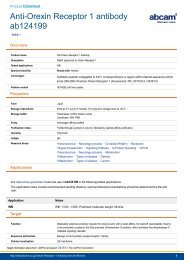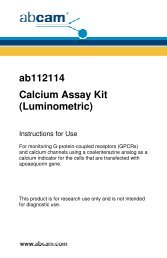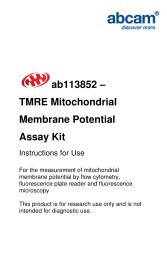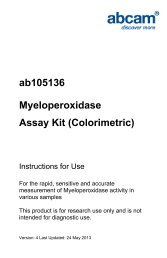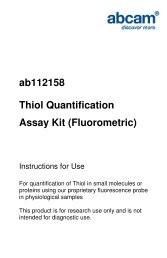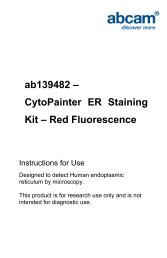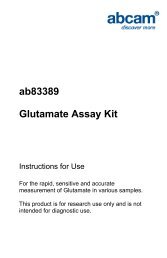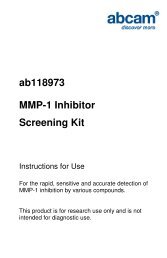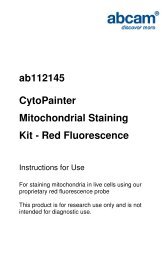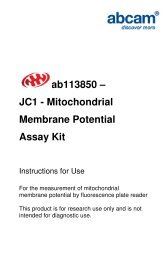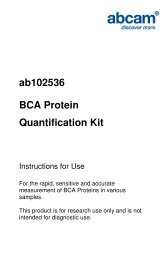ab102531 Trypsin Activity Assay Kit (Colorimetric) - Abcam
ab102531 Trypsin Activity Assay Kit (Colorimetric) - Abcam
ab102531 Trypsin Activity Assay Kit (Colorimetric) - Abcam
You also want an ePaper? Increase the reach of your titles
YUMPU automatically turns print PDFs into web optimized ePapers that Google loves.
<strong>ab102531</strong><strong>Trypsin</strong> <strong>Activity</strong> <strong>Assay</strong><strong>Kit</strong> (<strong>Colorimetric</strong>)Instructions for UseFor the rapid, sensitive and accuratemeasurement of <strong>Trypsin</strong> activity in varioussamples.This product is for research use only and is notintended for diagnostic use.
<strong>ab102531</strong> <strong>Trypsin</strong> <strong>Activity</strong> <strong>Assay</strong> <strong>Kit</strong> (<strong>Colorimetric</strong>)1
<strong>ab102531</strong> <strong>Trypsin</strong> <strong>Activity</strong> <strong>Assay</strong> <strong>Kit</strong> (<strong>Colorimetric</strong>)Table of Contents1. Overview 32. Protocol Summary 43. Components and Storage 54. <strong>Assay</strong> Protocol 75. Data Analysis 96. Troubleshooting 112
<strong>ab102531</strong> <strong>Trypsin</strong> <strong>Activity</strong> <strong>Assay</strong> <strong>Kit</strong> (<strong>Colorimetric</strong>)1. Overview<strong>Trypsin</strong> (EC 3.4.21.4) is a serine protease found in the digestivesystem of many vertebrates, where it hydrolyses proteins. <strong>Trypsin</strong> isproduced in the pancreas as the inactive proenzyme trypsinogen.Active trypsin predominantly cleaves peptide chains at the carboxylside of the amino acids lysine or arginine, except when either isfollowed by proline. It is used for numerous biotechnologicalprocesses.In <strong>Abcam</strong>’s <strong>Trypsin</strong> <strong>Activity</strong> <strong>Assay</strong> <strong>Kit</strong> (<strong>Colorimetric</strong>), trypsin cleavesa substrate to generate p-nitroaniline (p-NA) which is detected atλ=405 nm. Since the color intensity is proportional to p-NA content,trypsin activity can be accurately measured. The kit detects10-100 mU (p-NA unit) trypsin in various samples.3
<strong>ab102531</strong> <strong>Trypsin</strong> <strong>Activity</strong> <strong>Assay</strong> <strong>Kit</strong> (<strong>Colorimetric</strong>)2. Protocol SummarySample PreparationStandard Curve PreparationAdd Reaction MixMeasure Absorbance4
<strong>ab102531</strong> <strong>Trypsin</strong> <strong>Activity</strong> <strong>Assay</strong> <strong>Kit</strong> (<strong>Colorimetric</strong>)3. Components and StorageA. <strong>Kit</strong> ComponentsItemQuantity<strong>Trypsin</strong> <strong>Assay</strong> Buffer<strong>Trypsin</strong> Substrate (in DMSO) 200 µlPositive Control (~2U, Lyophilized)25 mL0.2 mL1 vialp-NA Standard (2 mM) 400 µL<strong>Trypsin</strong> Inhibitor (TLCK, 20 mM) 100 µLChymotrypsin Inhibitor (TPCK,10 mM) 100 µL* Store kit at –20°C.TRYPSIN SUBSTRATE, p-NA STANDARD, TRYPSIN INHIBITORand CHYMOTRYPSIN INHIBITOR are in DMSO solution, thus needto be warmed up to room temperature to become liquid before use.POSITIVE CONTROL: Dissolve with 100 µl <strong>Assay</strong> Buffer. Pipette upand down to completely dissolve, aliquot and store at -20°C. Usewithin two months. Prevent from freeze/thaw cycle.5
<strong>ab102531</strong> <strong>Trypsin</strong> <strong>Activity</strong> <strong>Assay</strong> <strong>Kit</strong> (<strong>Colorimetric</strong>)B. Additional Materials Required• Microcentrifuge• Pipettes and pipette tips• <strong>Colorimetric</strong> microplate reader• 96 well plate• Orbital shaker6
<strong>ab102531</strong> <strong>Trypsin</strong> <strong>Activity</strong> <strong>Assay</strong> <strong>Kit</strong> (<strong>Colorimetric</strong>)4. <strong>Assay</strong> Protocol1. Sample and Positive Control Preparation:Tissues or cells can be extracted with 4 volumes of the <strong>Trypsin</strong><strong>Assay</strong> Buffer, centrifuge in micro-centrifuge at top speed for 10 minto get a clear extract.a) Prepare test samples at 50 µl/well with <strong>Assay</strong> Buffer in a 96-wellplate. Serum can be directly added into sample wells, and thevolume adjusted to 50 µl/well with <strong>Assay</strong> Buffer.We suggest using several doses of your sample to ensure thereadings are within the linear range.b) Treat with 1 µl of 50X chymotrypsin inhibitor (TPCK) solutionand incubate for 10 minutes at room temperature.Notes:a) For the positive control, add 5 µl positive control solution towells, adjust volume to 50 µl/well with <strong>Assay</strong> Buffer.b) If desired, set a trypsin inhibitor sample group as a control byadding 1 µl of 50X trypsin inhibitor (TLCK) solution to trypsininhibitor sample control and incubate for 5 min.2. Standard Curve Preparation:Add 0, 2, 4, 6, 8, 10 µl p-NA standard into a series of standardswells. Adjust volume to 50 µl/well with <strong>Trypsin</strong> <strong>Assay</strong> Buffer togenerate 0, 4, 8, 12, 16, and 20 nmol/well of the p-NA standard.7
<strong>ab102531</strong> <strong>Trypsin</strong> <strong>Activity</strong> <strong>Assay</strong> <strong>Kit</strong> (<strong>Colorimetric</strong>)3. Reaction Mix Preparation:Mix enough reagents for the number of assays to be performed. Foreach well, prepare a total 50 µl Reaction Mix containing:<strong>Assay</strong> Buffer 48 µl<strong>Trypsin</strong> Substrate 2 µlMix well and add 50 µl of the reaction mix to each well containing thep-NA standards, positive controls, test samples or test samples withtrypsin inhibitor control, mix well, incubate at 25°C, protected fromlight.4. MeasurementInitially measure absorbance at 405 nm at time T 1 (A 1 and A 1C fortrypsin inhibitor control). After incubating the reaction for 1-2 hours(or incubate longer time if the trypsin activity is low) measure theabsorbance at T 2 (A 2 and A 2C ).The color generated by cleavage of substrate is:∆A 405nm = (A 2 – A 2C ) – (A 1 – A 1C )Or(A 2 – A 1 ), if no trypsin inhibitor control was run.Note:It is essential to read A 1 and A 2 in the reaction linear range. It will bemore accurate if you read the reaction kinetics. Then choose A 1 andA 2 in the reaction linear range.8
<strong>ab102531</strong> <strong>Trypsin</strong> <strong>Activity</strong> <strong>Assay</strong> <strong>Kit</strong> (<strong>Colorimetric</strong>)5. Data AnalysisSubtract zero standard from all readings.Plot the p-NA standard Curve. Apply the ∆A 405nm to the standardcurve to get the nmol of p-NA (amount generated between T 1 and T 2in the reaction wells).<strong>Trypsin</strong><strong>Activity</strong> =Bx Sample Dilution Factor = nmol/min/ml = mU/ml(T 1 – T 2) x VWhere:B is the p-NA calculated from the Standard Curve (in nmol).T 1 and T 2 are the times of the first and second readings (in min).V is the pretreated sample volume added into the reaction well(in ml).Unit Definition: One unit is defined as the amount of trypsin thatcleaves the substrate, yielding 1.0 µmol of p-NA per minute at 25°C.Note: 1 p-NA Unit = 0.615 TAME Unit = 35 BAEE Unit.9
<strong>ab102531</strong> <strong>Trypsin</strong> <strong>Activity</strong> <strong>Assay</strong> <strong>Kit</strong> (<strong>Colorimetric</strong>)10
<strong>ab102531</strong> <strong>Trypsin</strong> <strong>Activity</strong> <strong>Assay</strong> <strong>Kit</strong> (<strong>Colorimetric</strong>)6. TroubleshootingProblem Reason Solution<strong>Assay</strong> notworkingUnexpectedresults<strong>Assay</strong> buffer atwrong temperatureProtocol step missedPlate read atincorrect wavelengthUnsuitable microtiterplate for assayMeasured at wrongwavelengthSamples containimpeding substancesUnsuitable sampletypeSample readings areoutside linear range<strong>Assay</strong> buffer must not be chilled- needs to be at RTRe-read and follow the protocolexactlyEnsure you are usingappropriate reader and filtersettings (refer to datasheet)Fluorescence: Black plates(clear bottoms);Luminescence: White plates;Colorimetry: Clear plates.If critical, datasheet will indicatewhether to use flat- or U-shapedwellsUse appropriate reader and filtersettings described in datasheetTroubleshoot and also considerdeproteinizing samplesUse recommended samplestypes as listed on the datasheetConcentrate/ dilute samples tobe in linear range11
<strong>ab102531</strong> <strong>Trypsin</strong> <strong>Activity</strong> <strong>Assay</strong> <strong>Kit</strong> (<strong>Colorimetric</strong>)SampleswithinconsistentreadingsLower/Higherreadings insamplesandstandardsUnsuitable sampletypeSamples prepared inthe wrong bufferSamples notdeproteinized (ifindicated ondatasheet)Cell/ tissue samplesnot sufficientlyhomogenizedToo many freezethawcyclesSamples containimpeding substancesSamples are too oldor incorrectly storedNot fully thawed kitcomponentsOut-of-date kit orincorrectly storedreagentsReagents sitting forextended periods oniceIncorrect incubationtime/ temperatureIncorrect amountsusedRefer to datasheet for detailsabout incompatible samplesUse the assay buffer provided(or refer to datasheet forinstructions)Use the 10kDa spin column(ab93349)Increase sonication time/number of strokes with theDounce homogenizerAliquot samples to reduce thenumber of freeze-thaw cyclesTroubleshoot and also considerdeproteinizing samplesUse freshly made samples andstore at recommendedtemperature until useWait for components to thawcompletely and gently mix prioruseAlways check expiry date andstore kit components asrecommended on the datasheetTry to prepare a fresh reactionmix prior to each useRefer to datasheet forrecommended incubation timeand/ or temperatureCheck pipette is calibratedcorrectly (always use smallestvolume pipette that can pipetteentire volume)12
<strong>ab102531</strong> <strong>Trypsin</strong> <strong>Activity</strong> <strong>Assay</strong> <strong>Kit</strong> (<strong>Colorimetric</strong>)Problem Reason SolutionStandardcurve is notlinearNot fully thawed kitcomponentsPipetting errors whensetting up thestandard curveIncorrect pipettingwhen preparing thereaction mixAir bubbles in wellsConcentration ofstandard stockincorrectErrors in standardcurve calculationsUse of otherreagents than thoseprovided with the kitWait for components to thawcompletely and gently mix prioruseTry not to pipette too smallvolumesAlways prepare a master mixAir bubbles will interfere withreadings; try to avoid producingair bubbles and always removebubbles prior to reading platesRecheck datasheet forrecommended concentrations ofstandard stocksRefer to datasheet and re-checkthe calculationsUse fresh components from thesame kitFor further technical questions please do not hesitate tocontact us by email (technical@abcam.com) or phone (select“contact us” on www.abcam.com for the phone number foryour region).13
<strong>ab102531</strong> <strong>Trypsin</strong> <strong>Activity</strong> <strong>Assay</strong> <strong>Kit</strong> (<strong>Colorimetric</strong>)14
UK, EU and ROWEmail: technical@abcam.comTel: +44 (0)1223 696000www.abcam.comUS, Canada and Latin AmericaEmail: us.technical@abcam.comTel: 888-77-ABCAM (22226)www.abcam.comChina and Asia PacificEmail: hk.technical@abcam.comTel: 108008523689 ( 中 國 聯 通 )www.abcam.cnJapanEmail: technical@abcam.co.jpTel: +81-(0)3-6231-0940www.abcam.co.jpCopyright © 2012 <strong>Abcam</strong>, All Rights Reserved. The <strong>Abcam</strong> logo is a registered trademark.All information / detail is correct at time of going to print.



